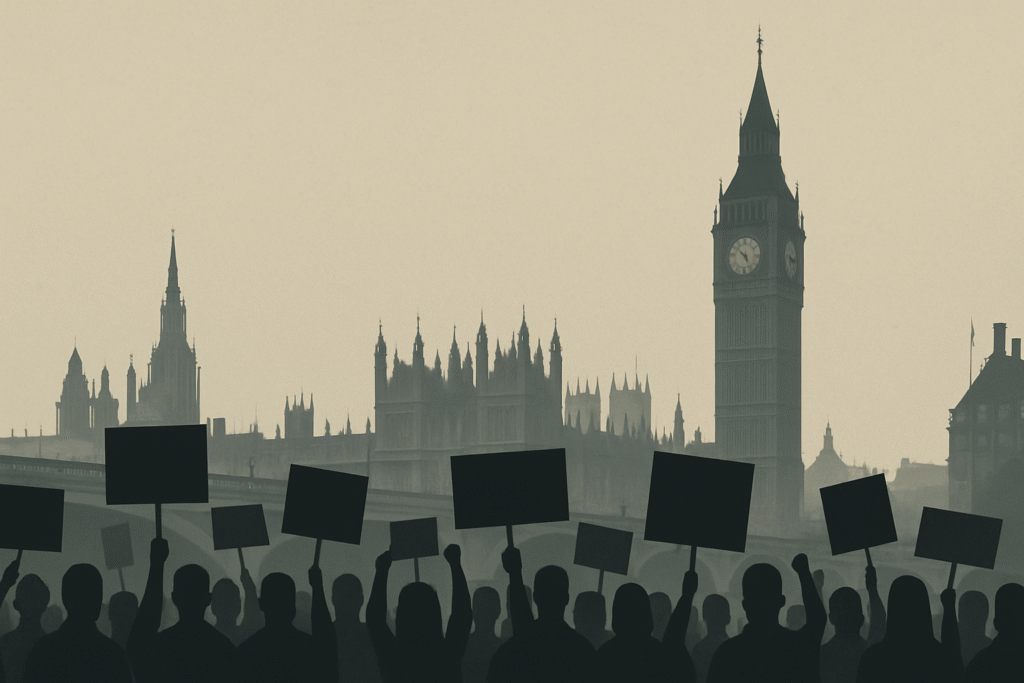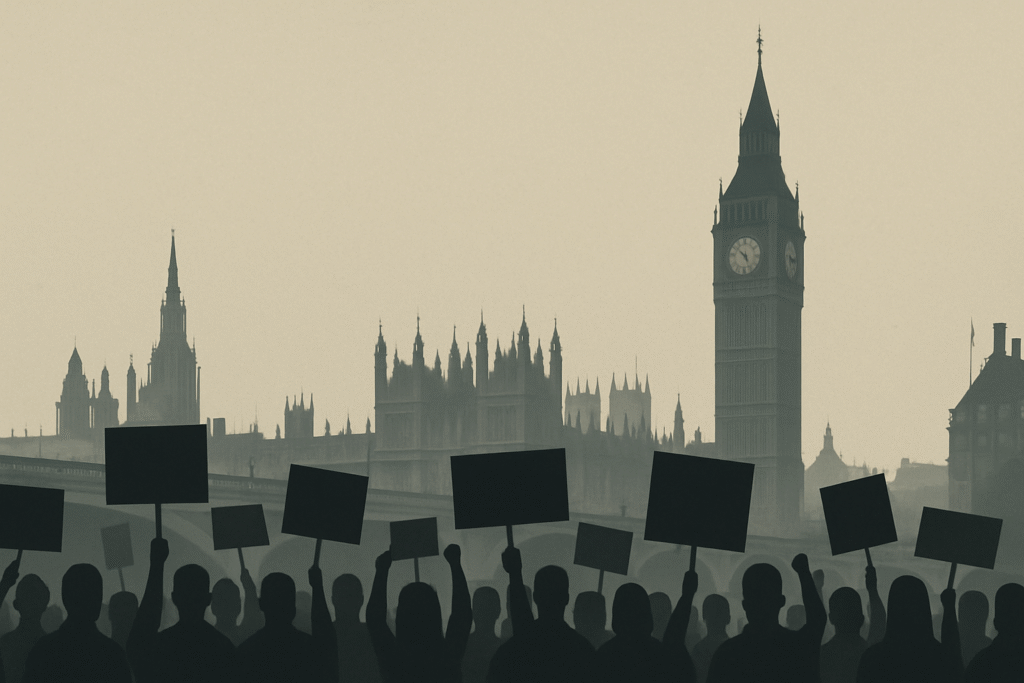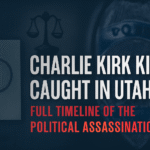
The anti-immigration protest in central London on September 13, 2025, drew an estimated 1 lakh-plus participants, with police placing the crowd at roughly 110,000 and upper estimates reaching 150,000, making it one of the largest right-wing demonstrations in modern UK history. Organized under the banner “Unite the Kingdom” by far-right activist Tommy Robinson, the march saw clashes with police, at least 25 arrests, and 26 injured officers as tensions flared with counter-protesters and during containment efforts across Whitehall and near Westminster.
Key points at a glance:
- Estimated turnout ranged from roughly 110,000 to as high as 150,000, with police citing about 110,000 attendees and several outlets noting upper estimates nearer 150,000.
- The event was organized by Tommy Robinson under the “Unite the Kingdom” banner and framed by supporters as a “free speech festival” aligned against immigration and asylum policies.
- Police reported “unacceptable violence,” at least 25 arrests, and 26 officers injured amid efforts to keep protesters and counter-protesters apart across central London.
- A counter-demonstration led by Stand Up To Racism drew around 5,000 people and was kept separate by a deployment of roughly 1,000 officers.
What happened
On Saturday, September 13, 2025, central London hosted a large “Unite the Kingdom” rally opposing immigration, with marchers waving the Union Jack and St George’s Cross as they moved through areas around Westminster and Whitehall. Police intervened repeatedly to maintain separation from a counter-protest and to prevent breaches of cordons, reporting assaults, thrown projectiles, and serious injuries to officers during the unrest. The demonstration capped a week-plus of mobilizations across Britain against immigration and asylum accommodations, reflecting broader national tensions that had been building over the summer.
When and where
The protest occurred on September 13, 2025, concentrating around Trafalgar Square, Whitehall, Westminster Bridge, and near Downing Street in central London, creating a high-profile march route visible at key government and civic landmarks. The Metropolitan Police imposed conditions and brought in reinforcements to end events by evening, aiming to minimize prolonged disorder and manage potential flashpoints along the route.
Who organized it and why
The gathering was spearheaded by Stephen Yaxley-Lennon (Tommy Robinson), a far-right activist with a substantial online following, who promoted the event as the country’s “biggest free speech festival” focused on opposition to recent immigration trends and policies. Messaging at and around the rally invoked themes such as stopping small-boat crossings and reclaiming the country, reflecting a nationalist framing and skepticism of asylum systems and broader migration.
How many people attended?
Police estimated attendance at around 110,000 while some reports cited a range up to 150,000, placing the rally among the biggest right-wing demonstrations in recent UK memory. Multiple outlets described the event as one of the largest such mobilizations in decades, underscoring its scale compared with prior far-right or anti-immigration marches.
What was seen on the ground.
Participants were widely photographed carrying England and UK flags, with placards and chants that referenced stopping the boats, sending migrants back, and anger at current leadership, highlighting a confrontational tone. Visuals captured marchers crossing Westminster Bridge and assembling for speeches, alongside lines of police seeking to hold perimeters and prevent surges toward counter-protesters.
Police response and injuries
The Metropolitan Police reported “unacceptable violence,” with 26 officers injured—four seriously—and at least 25 arrests tied to disorder, assaults on officers, and attempts to breach safety lines. Around 1,000 officers, with mounted units and protective equipment, were deployed to separate the main march from a counter-demonstration and to control volatile pockets as tensions spiked.
Counter-protests and civil society response:
Stand Up To Racism organized a counter-protest of approximately 5,000 people, rallying behind messages welcoming refugees and condemning far-right narratives while attempting to avoid confrontation with the main march. Lawmakers and activists at the counter-rally criticized what they termed dangerous misinformation about asylum seekers and urged solidarity with migrant communities.
Notable speakers and messages
The platform featured speeches amplifying anti-immigration themes, with reports noting a video appearance by Elon Musk alongside European far-right figures such as Eric Zemmour and Petr Bystron in a program that drew criticism for “great replacement” rhetoric and conspiratorial narratives. Organizers framed the event as a turning point, using language about Cultural Revolution and reclaiming national identity to galvanize supporters.
Political context and backdrop
The rally unfolded amid a broader rise in anti-immigration mobilization across the UK in 2025, with protests outside asylum accommodations and an intensified online ecosystem amplifying grievances and coordination. Rising support for Reform UK and other right-leaning currents, alongside persistent small-boat crossings, has turned migration into a central flash point in British politics, contributing to the scale and urgency of such demonstrations.
Online coordination and misinformation.
Monitoring groups and analyzes of 2025 mobilizations have highlighted the role of social media platforms—particularly Telegram and X—in facilitating coordination by far-right networks and in amplifying polarizing narratives around asylum and crime. Authorities and independent reviews have linked prolonged circulation of misinformation to spikes in disorder, noting that online ecosystems served as accelerants during periods of heightened tension.
Comparison with other large marches
While massive in scale, the 110,000–150,000 turnout remains below the 2023 pro-Palestinian London march that was estimated at around 300,000, though the 2025 event stands out for the UK right-wing space specifically. Analysts and media described the day as possibly the largest far-right demonstration in Britain, placing it in a distinct category versus broader coalitions seen in other large UK gatherings.
Law, order, and policing approach:
Police imposed conditions to manage routes, timings, and separation between opposing groups, citing obligations to balance the right to protest with public safety and the prevention of disorder. The force signaled that arrests on the day were not the end of enforcement, with ongoing efforts to identify and charge individuals involved in violence or serious public order offenses.
Impact on politics and policy debates.
The scale and visibility of the march intensified national debates over migration levels, small-boat crossings, asylum accommodation, and the broader direction of UK immigration policy. Coverage emphasized that the rally sits within a dynamic where immigration’s salience has risen, shaping party strategies, parliamentary discourse, and civil society mobilization across multiple fronts.
Community and city impacts
Central London saw significant policing footprints and intermittent disruptions around classic march corridors such as Whitehall and Westminster, with authorities aiming to clear areas by evening to stabilize the city center. Visual evidence and reporting documented tense standoffs near institutional buildings, underscoring the challenges of managing rival mobilizations in high-density civic spaces.
Media coverage and framing
International and British outlets framed the protest as a landmark moment for the UK’s far-right movement, underlining both the turnout and the confrontations with police as key news angles. Photo-led pieces and live updates showcased the flags, signs, and lines of officers, while analysis sections contextualized the surge with ongoing national debates about migration and social cohesion.
What to watch next?
Authorities indicated post-event investigations would continue, suggesting further arrests and charges are likely as they review footage and identify offenders. Politically, the march’s size and messaging will feed into legislative and campaign conversations about border control, asylum processing, public order policing, and online misinformation in the months ahead.
FAQs:
Q: When did the protest take place, and where did it gather?
A: The march occurred on September 13, 2025, with the largest concentrations around Trafalgar Square, Whitehall, Westminster Bridge, and near Downing Street in central London.
Q: How many people attended?
A: Police estimated around 110,000 attendees, while multiple outlets cited an upper range up to 150,000, marking it as among the biggest right-wing rallies in recent UK history.
Q: Who organized the event?
A: The protest was organized by Tommy Robinson under the “Unite the Kingdom” banner, drawing a broad far-right audience and online supporters.
Q: Was the rally peaceful?
A: There were significant clashes and disorder, with police reporting “unacceptable violence,” at least 25 arrests, and 26 officers injured during confrontations and containment efforts.
Q: There were counter-protests?
A: Yes, Stand Up To Racism organized a counter-demonstration of roughly 5,000 people, which police kept separate from the main march using substantial manpower and cordons.
Q: What messages and themes dominated the march?
A: Slogans included “stop the boats” and “send them home,” alongside calls to “reclaim” the country and critical chants targeting current leadership, framed within a nationalist and anti-immigration narrative.
Q: Did any notable figures address the crowd?
A: Reports highlighted a video address by Elon Musk and appearances by European far-right figures such as Eric Zemmour and Petr Bystron, amplifying anti-immigration and “great replacement” themes.
Q: How did the police prepare and respond?
A: Approximately 1,000 officers were deployed, including mounted units and reinforcements with protective gear, with conditions imposed on timing and routes to reduce risk of disorder.
Q: How does this compare to other recent UK marches?
A: While very large for a right-wing rally, it remained smaller than the November 2023 pro-Palestinian march estimated atat aboutat 300,000, though analysts labeled the 2025 rally among the largest far-right gatherings seen in Britain.
Q: What broader context explains the march’s size?
A: A year of heightened tensions around asylum hotels, small-boat crossings, and energized online ecosystems helped scale the mobilization, with political currents like Reform UK shaping the backdrop.
Q: Did the rally affect public policy immediately?
A: Immediate policy shifts were not reported on the day, but the scale and intensity of the protest are likely to influence the policy debate on immigration, asylum, policing, and online misinformation going forward.
Q: What legal consequences are participants facing?
A: Police signaled that the 25 arrests were the start of a wider effort to identify offenders from video and photos, with further arrests and charges anticipated post-event.
Q: Is this part of a larger trend in the UK?
A: Yes, the rally capped more than a week of demonstrations and forms part of a broader wave of 2025 anti-immigration protests documented across multiple English localities.
Q: What is “Unite the Kingdom”?
A: It is the branding used by organizers led by Tommy Robinson for the London rally, pitched as a mass protest against immigration and a platform for speakers aligned to nationalist and anti-immigration positions.
Q: How did civil society respond?
A: Anti-racism groups and sympathetic lawmakers condemned the rally’s rhetoric and urged solidarity with asylum seekers, emphasizing the need to counter misinformation and protect social cohesion.
Q: What should observers monitor next?
A: Watch for further arrests, parliamentary debate intensity, and how upcoming policy announcements address small-boat crossings, asylum processing, and policing of large-scale demonstrations.
Sources to know
- Police and mainstream outlets consistently report an estimated attendance of around 110,000, with some noting upper figures as high as 150,000.
- Disorder included assaults on officers, thrown projectiles, and multiple arrests, prompting post-event investigations to identify additional offenders.
- The counter-protest drew about 5,000 participants and was kept separate by heavy police deployment throughout central London.
- The rally fits into a wider 2025 pattern of mobilizations over asylum accommodations and migration, with online networks playing a key role in organizing and amplifying narratives.



